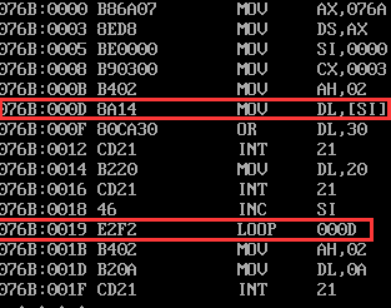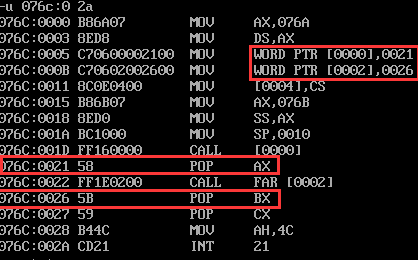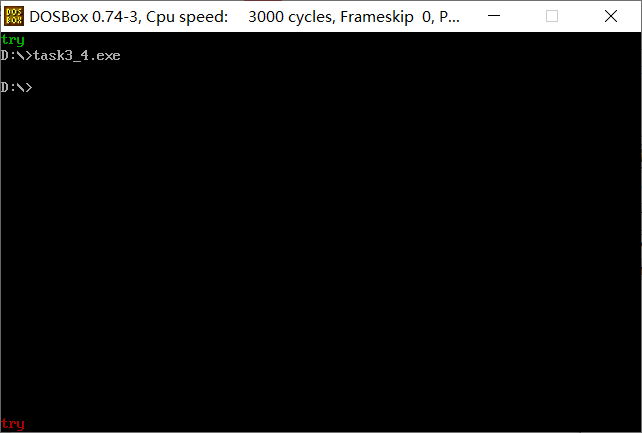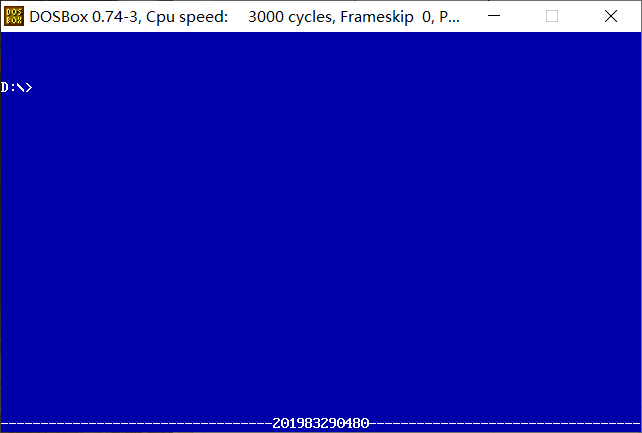4, Experimental conclusion
1. Experimental task 1
Contents of this part:
- Give the program task1.asm source code, and run screenshots
1 assume cs:code, ds:data 2 3 data segment 4 x db 1, 9, 3 5 len1 equ $ - x 6 7 y dw 1, 9, 3 8 len2 equ $ - y 9 data ends 10 11 code segment 12 start: 13 mov ax, data 14 mov ds, ax 15 16 mov si, offset x 17 mov cx, len1 18 mov ah, 2 19 s1:mov dl, [si] 20 or dl, 30h 21 int 21h 22 23 mov dl, ' ' 24 int 21h 25 26 inc si 27 loop s1 28 29 mov ah, 2 30 mov dl, 0ah 31 int 21h 32 33 mov si, offset y 34 mov cx, len2/2 35 mov ah, 2 36 s2:mov dx, [si] 37 or dl, 30h 38 int 21h 39 40 mov dl, ' ' 41 int 21h 42 43 add si, 2 44 loop s2 45 46 mov ah, 4ch 47 int 21h 48 code ends 49 end start

- Answer question ①
① line27, when the assembly instruction loop s1 jumps, it jumps according to the displacement. Check the machine code through debug disassembly and analyze the jump displacement? (the displacement value is answered in decimal) from the perspective of the CPU, explain how to calculate the offset address of the instruction after the jump label s1.

0Dh-1Bh=F2h is converted to decimal system as - 14, that is, the skip displacement is - 14
From the perspective of CPU, after the loop instruction,
Jump address = address of the first byte after the loop instruction + (address at "label" - address of the first byte after the loop instruction)
Simple calculation: jump address = 1Bh + (0Dh-1Bh) = 0Dh
In the computer, the offset is represented by an eight bit binary complement, and the subtraction of the complement is converted into addition for calculation. The actual calculation process is as follows:
1. First calculate the 8-bit offset - "address at label" - the address of the first byte after the loop instruction
0000 1101 (0D binary complement form)
0001 1011 (1B binary complement form)
1110 0101 (- binary complement form of 1B)
0000 1101-0001 1011 = 0000 1101 + 1110 0101 = 1111 0010 (binary complement form of F2)
In the computer, the machine code is represented by complement. You can see the machine code E2F2. F2 represents the calculated offset and is converted into decimal-14.
2. Add the offset and the first byte address after the loop instruction:
0001 1011 + 1111 0010 = 0000 1101 (binary complement form of 0D)
- Answer question ②
② line44. When the assembly instruction loop s2 jumps, it jumps according to the displacement. Check the machine code through debug disassembly and analyze the jump displacement? (the displacement value is answered in decimal) from the perspective of the CPU, explain how to calculate the offset address of the instruction after the jump label s2.

As shown in question ①, the offset = 29h-39h=f0h is converted to decimal - 16
The CPU angle will not be repeated.
2. Experimental task 2
Contents of this part:
- The program task2.asm source code is given
1 assume cs:code, ds:data 2 3 data segment 4 dw 200h, 0h, 230h, 0h 5 data ends 6 7 stack segment 8 db 16 dup(0) 9 stack ends 10 11 code segment 12 start: 13 mov ax, data 14 mov ds, ax 15 16 mov word ptr ds:[0], offset s1 17 mov word ptr ds:[2], offset s2 18 mov ds:[4], cs 19 20 mov ax, stack 21 mov ss, ax 22 mov sp, 16 23 24 call word ptr ds:[0] 25 s1: pop ax 26 27 call dword ptr ds:[2] 28 s2: pop bx 29 pop cx 30 31 mov ah, 4ch 32 int 21h 33 code ends 34 end start
- After analysis, debugging and verification, register (ax) =? (bx) = (cx) =? Attach the screenshot of the debugging result interface.

(ax)=0021 (bx)=0026 (cx)=076C
① According to the jump principle of call instruction, it is analyzed theoretically that before the program executes to exit (line31), register (ax) =? Register (bx) =? Register (cx) =?
line 13-14 assigns the first address of the data segment to the ds register
line 16-18 take the IP of label s1 and store it in ds[0] address,
Take the IP labeled s2 and store it in the first address of the next byte, that is, ds[2] address,
Take the first address of cs segment and store it in the first address of the next byte, namely ds[4]
line 20-23 assigns the first address of the stack segment to the ss register and points the stack segment pointer to the top of the stack
line 24 stacks the IP address of the next statement and transfers it to the address pointed to by ds[0]. It can be seen from the above that it is the s1 label address
line 25 assigns the data pointed to by the current stack top pointer to bx. It can be seen from the above that it is the s1 label IP address
The line 27 program continues to execute downward, putting the next statement IP on the stack, and then CS on the stack. The program jumps to the address pointed to by ds[2], that is, the s2 label address
line 28 assigns the data pointed to by the current stack top pointer to bx, that is, the current address CS value
line 28 assigns the data pointed to by the current stack top pointer to cx, that is, the current address IP value
② Assemble and link the source program to get the executable program task2.exe. Use debug to debug, observe and verify debugging
Whether the results are consistent with the theoretical analysis results.

It can be seen from the disassembly of the source program that the address of s1 labeled at line16 is 0021, which is consistent with the location of s1 labeled below. The same is true for line17.
Before the program is executed, 16 bytes are pre stored in the stack, all of which are 0.

Step to line25, and the data in the stack is:

It can be seen that 0021 enters the stack. At the same time, because of the single-step execution of the protection site, the CS and IP values of the next command are also stored in the stack.
Continue to line 27. The data in the stack is:

You can see that the IP and CS values of the next instruction are stacked.
The program continues to line29, and the results are as follows:

The results are consistent with the theoretical analysis.
3. Experimental task 3
Contents of this part:
- The program source code task3.asm is given
1 assume cs:code, ds:data 2 data segment 3 x db 99, 72, 85, 63, 89, 97, 55 4 len equ $- x 5 data ends 6 7 code segment 8 start: 9 mov ax, data 10 mov ds, ax 11 mov si, offset x 12 mov cx, len 13 mov bl,10 14 15 s1:mov ah,0 16 mov al, [si] 17 div bl 18 or al,30h 19 mov dh,al;Deposit quotient 20 or ah,30h 21 mov bh,ah;Residual 22 23 mov ah,2 24 ;Output quotient 25 mov dl,dh 26 int 21h 27 ;Output remainder 28 mov dl,bh 29 int 21h 30 ;Output space 31 mov dl, ' ' 32 int 21h 33 34 inc si 35 loop s1 36 37 mov ah,4ch 38 int 21h 39 code ends 40 end start
- Screenshot of running test

4. Experimental task 4
Contents of this part:
- The program source code task4.asm is given
1 assume cs:code,ds:data 2 3 data segment 4 str db 'try' 5 len equ $-str 6 data ends 7 8 code segment 9 start: 10 mov ax,data 11 mov ds,ax 12 13 mov ax,0b800h 14 mov es,ax 15 mov bx,0h;first line 16 17 mov si,offset str 18 mov cx,len 19 s1: 20 mov dl,[si];Low storage character Ascii code 21 mov es:[bx],dl 22 mov dl,2h;set a property 23 mov es:[bx+1],dl;Property is placed in the high-order address of the display address 24 25 add bx,2 26 inc si 27 loop s1 28 29 mov bx,0f00h;Line 25 30 mov cx,len 31 mov si,offset str 32 s2: 33 mov dl,[si];Low storage character Ascii code 34 mov es:[bx],dl 35 mov dl,4h;set a property 36 mov es:[bx+1],dl;Property is placed in the high-order address of the display address 37 38 add bx,2 39 inc si 40 loop s2 41 42 43 mov ah,4ch 44 int 21h 45 code ends 46 end start
- Screenshot of running test

5. Experimental task 5
Contents of this part:
- The program source code task5.asm is given
1 assume cs:code,ds:data 2 3 data segment 4 stu_no db '201983290480' 5 len = $-stu_no 6 data ends 7 8 code segment 9 start: 10 mov ax,data 11 mov ds,ax 12 13 mov ax,0b800h 14 mov es,ax 15 16 mov bx,0 17 mov cx,1920 18 call s1 19 20 mov bx,0f00h 21 Tos2: mov cx,34 22 call s2 23 24 mov si,offset stu_no 25 mov cx,len 26 mov bx,0f44h 27 call s3 28 29 mov ah,4ch 30 int 21h 31 32 s1: 33 mov dl,' ' 34 mov es:[bx],dl 35 mov dl,1fh 36 mov es:[bx+1],dl 37 add bx,2 38 loop s1 39 ret 40 41 s2: 42 mov dl,'-' 43 mov es:[bx],dl 44 mov dl,1fh 45 mov es:[bx+1],dl 46 add bx,2 47 loop s2 48 ret 49 50 s3: 51 mov dl,[si] 52 mov es:[bx],dl 53 mov dl,1fh 54 mov es:[bx+1],dl 55 add bx,2 56 inc si 57 cmp cx,1;If=1,Jump 58 je Tos2 59 loop s3 60 ret 61 62 code ends 63 end start
- Screenshot of running test

5, Experimental summary
Summary of knowledge points:
1.EQU pseudo instruction connects a symbol name with an integer expression or an arbitrary text. It has three formats:
name EQU expression
name EQU symbol
name EQU <text>
In the first format, expression must be a valid integer expression. In the second format, symbol is an existing symbol name, which has been defined with = or EQU. In the third format, any text can appear in <... >. When the assembler encounters name later in the program, it uses integer value or text to replace the symbol.
Unlike the = directive, symbols defined with EQU cannot be redefined in the same source code file. This restriction prevents existing symbols from being inadvertently assigned new values.
2.$
"$" yes assembly language A predefined symbol in, which is equivalent to the current offset value of the segment currently being assembled. For example, "$" in eg: instruction "jmp $+3" indicates the current offset value of this instruction in the code segment Offset.
eg, that is, "jmp $+3", means to jump forward to a place 3 bytes away from the instruction. If "jmp $-3", it means to jump back to a place 3 bytes away from the instruction.
In assembly, it is the flag of the end of the string
For example: DATA SEGMENT
MES1 'HELLO',0AH,0DH,'$'